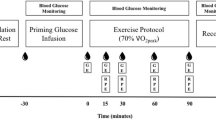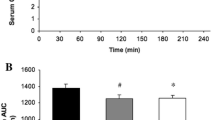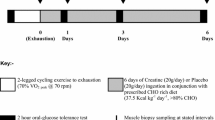Summary
Post-exercise ketosis is known to be suppressed by physical training and by a high carbohydrate diet. As a result it has often been presumed, but not proven, that the development of post-exercise ketosis is closely related to the glycogen content of the liver. We therefore studied the effect of 1 h of treadmill running on the blood 3-hydroxybutyrate and liver and muscle glycogen concentrations of carbohydrate-loaded trained (n=72) and untrained rats (n=72). Resting liver and muscle glycogen levels were 25%–30% higher in the trained than in the untrained animals. The resting 3-hydroxybutyrate concentrations of both groups of rats were very low: <0.08 mmol·1−1. Exercise did not significantly influence the blood 3-hydroxybutyrate concentrations of trained rats, but caused a marked post-exercise ketosis (1.40±0.40 mmol·1−1 1 h after exercise) in the untrained animals, the time-course of which was the approximate inverse of the changes in liver glycogen concentration. Interpreting the results in the light of similar data obtained after a normal and low carbohydrate diet it has been concluded that trained animals probably owe their relative resistance to post-exercise ketosis to their higher liver glycogen concentrations as well as to greater peripheral stores of mobilizable carbohydrate.
Similar content being viewed by others
References
Adams JH, Koeslag JH (1988) Carbohydrate homeostasis and postexercise ketosis in trained and untrained rats. J Physiol 407:453–461
Adams JH, Koeslag JH (1989) Glycogen metabolism and postexercise ketosis in carbohydrate-restricted trained and untrained rats. Q J Exp Physiol 74:27–34
Adams JH, Irving G, Koeslag JH, Lochner JdeV, Sandell RC, Wilkinson C (1987)β-Adrenergic blockade restores glucose's antiketogenic activity after exercise in carbohydrate-depleted athletes. J Physiol 386:439–454
Askew EW, Dohm RL, Huston RL (1975) Fatty acid and ketone body metabolism in the rat: response to diet and exercise. J Nutr 105:1422–1432
Baldwin KM, Fitts RH, Booth FW, Winder WW (1975) Depletion of muscle and liver glycogen during exercise: adaptive response to exercise. Pflügers Arch 354:203–212
Beattie MA, Winder WW (1985) Attenuation of post-exercise ketosis in fasted endurance-trained rats. Am J Physiol 248:R63-R67
Boyd ME, Albright EB, Foster DW, McGarry JD (1981) In vitro reversal of the fasting state of liver metabolism in the rat. Reevaluation of the roles of insulin and glucose. J Clin Invest 68:142–152
Brooks GA (1986) Lactate production under fully aerobic conditions: the lactate shuttle during rest and after exercise. Fed Proc 45:2924–2929
Courtice FC, Douglas CG (1936) The effects of prolonged muscular exercise on the metabolism. Proc Roy Soc Lond [Biol] 119:381–439
Foster DW (1984) Banting Lecture 1984. From glycogen to ketones — and back. Diabetes 33:1188–1199
Good CA, Kramer H, Somogyi M (1933) The determination of glycogen. J Biol Chem 100:485–491
Jansson E, Kaijser L (1982) Effect of diet on muscle glycogen and blood glucose utilization during short-term exercise. Acta Physiol Scand 115:341–347
Johnson RH, Walton JL (1971) Fitness, fatness and post-exercise ketosis. Lancet ii:452–455
Johnson RH, Rennie MJ, Walton JL, Webster MHC (1971) The effect of moderate exercise on blood metabolites in patients with hypopituitarism. Clin Sci 40:127–136
Katz J, Kuwajima M, Foster DW, McGarry JD (1986) The glucose paradox: new perspectives on hepatic carbohydrate metabolism. Trends Biochem Sci 11:136–140
Kelman GR, Maughan RJ, Williams C (1975) The effect of dietary modifications on blood lactate during exercise. J Physiol 251:34P-35P
Koeslag JH (1982) Post-exercise ketosis and the hormone response to exercise: a review. Med Sci Sports Exerc 14:327–334
Koeslag JH, Noakes TD, Sloan AW (1980) Post-exercise ketosis. J Physiol 301:79–90
Koeslag JH, Noakes TD, Sloan AW (1982) The effect of alanine, glucose and starch ingestion on the ketosis produced by exercise and by starvation. J Physiol 325:363–376
Koeslag JH, Levinrad LI, Lochner JdeV, Sive AA (1985) Postexercise ketosis in post-prandial exercise: effect of glucose and alanine ingestion in humans. J Physiol 358:395–403
McGarry JD, Foster DW (1979) In support of the roles of malonyl CoA and carnitine acyltransferase I in the regulation of hepatic fatty acid oxidation and ketogenesis. J Biol Chem 254:8163–8168
Mehler AH, Kornberg A, Grisolia S, Ochoa S (1948) The enzymatic mechanism of oxidation-reduction between malate or isocitrate and pyruvate. J Biol Chem 174:961–1000
Mills JN (1938) The effects of prolonged exercise on the metabolism. J Physiol 93:144–158
Newgard CB, Hirsch LJ, Foster DW, McGarry JD (1983) Studies of the mechanism by which exogenous glucose is converted into liver glycogen in the rat — a direct or an indirect pathway? J Biol Chem 258:8046–8052
Rennie MJ, Johnson RH (1974a) Alteration of metabolic and hormonal responses to exercise by physical training. Eur J Appl Physiol 33:215–226
Rennie MJ, Johnson RH (1974b) Effects of an exercise-diet program on metabolic changes with exercise in runners. J Appl Physiol 37:821–825
Rennie MJ, Jennet S, Johnson RH (1974) The metabolic effects of strenuous exercise: a comparison between untrained subjects and racing cyclists. Q J Exp Physiol 59:201–212
Rennie MJ, Winder WW, Holloszy JO (1976) A sparing effect of increased plasma fatty acids on muscle and liver glycogen content in the exercising rat. Biochem J 156:647–655
Sherman WM, Costill DL, Flink WJ, Miller JM (1981) Effect of exercise-diet manipulation on muscle glycogen and its subsequent utilization during performance. Int J Sports Med 2:114–118
Vahed YAK, Koeslag JH, Lochner JdeV (1988) Beta-adrenergic blockade counteracts starvational ketosis, but aggravates post-exercise ketosis in non-athletes. J Endocrinol 119:167–171
Wasserman K (1967) Lactate and related acid base and blood gas changes during constant load and graded exercise. Can Med Assoc J 96:775–779
Williamson DH, Mellanby J, Krebs HA (1962) Enzymic determination of D (-)-β-hydroxybutyric acid and acetoacetic acid in blood. Biochem J 82:90–96
Winder WW, Holman RT, Garhart SJ (1981) Effect of endurance training on liver cAMP response to prolonged exercise. Am J Physiol 240:R330-R334
Winder WW, Beattie MA, Holman RT (1982) Endurance training attenuates stress hormone responses to exercise in fasted rats. Am J Physiol 243:R179-R184
Yoshida T (1984) Effect of dietary modifications on lactate threshold and onset of blood lactate accumulation during incremental exercise. Eur J Appl Physiol 53:200–205
Yoshida T (1986) Effects of dietary modifications on anaerobic threshold. Sports Med 3:4–9
Zorzano A, Balon TW, Goodman MN, Ruderman NB (1986) Glycogen depletion and increased insulin sensitivity and responsiveness in muscle after exercise. Am J Physiol 251:E664-E669
Author information
Authors and Affiliations
Rights and permissions
About this article
Cite this article
Adams, J.H., Koeslag, J.H. Post-exercise ketosis and the glycogen content of liver and muscle in rats on a high carbohydrate diet. Europ. J. Appl. Physiol. 59, 189–194 (1989). https://doi.org/10.1007/BF02386186
Accepted:
Issue Date:
DOI: https://doi.org/10.1007/BF02386186




